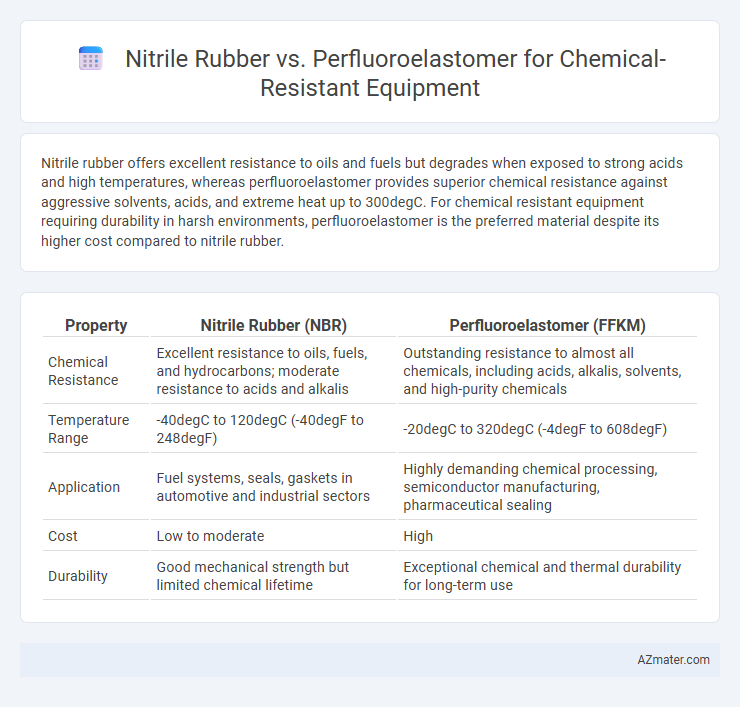Nitrile rubber offers excellent resistance to oils and fuels but degrades when exposed to strong acids and high temperatures, whereas perfluoroelastomer provides superior chemical resistance against aggressive solvents, acids, and extreme heat up to 300degC. For chemical resistant equipment requiring durability in harsh environments, perfluoroelastomer is the preferred material despite its higher cost compared to nitrile rubber.
Table of Comparison
| Property | Nitrile Rubber (NBR) | Perfluoroelastomer (FFKM) |
|---|---|---|
| Chemical Resistance | Excellent resistance to oils, fuels, and hydrocarbons; moderate resistance to acids and alkalis | Outstanding resistance to almost all chemicals, including acids, alkalis, solvents, and high-purity chemicals |
| Temperature Range | -40degC to 120degC (-40degF to 248degF) | -20degC to 320degC (-4degF to 608degF) |
| Application | Fuel systems, seals, gaskets in automotive and industrial sectors | Highly demanding chemical processing, semiconductor manufacturing, pharmaceutical sealing |
| Cost | Low to moderate | High |
| Durability | Good mechanical strength but limited chemical lifetime | Exceptional chemical and thermal durability for long-term use |
Introduction to Chemical Resistant Elastomers
Chemical resistant elastomers like nitrile rubber and perfluoroelastomer offer specialized performance in environments with aggressive chemicals. Nitrile rubber is widely used for its excellent resistance to oils, fuels, and some solvents, making it cost-effective for general applications. Perfluoroelastomers provide superior chemical resistance to a broader range of harsh chemicals, extreme temperatures, and oxidative environments, ideal for demanding industrial uses.
Overview of Nitrile Rubber (NBR)
Nitrile Rubber (NBR) is a synthetic elastomer known for its excellent resistance to oils, fuels, and various chemicals, making it a common choice for chemical-resistant equipment. It offers good mechanical strength and abrasion resistance while maintaining flexibility across a wide temperature range, typically from -40degC to 120degC. NBR is cost-effective and widely used in seals, gaskets, and hoses in industries handling petroleum-based fluids and many chemical compounds.
Overview of Perfluoroelastomer (FFKM)
Perfluoroelastomer (FFKM) is a high-performance synthetic rubber known for exceptional chemical resistance and thermal stability, outperforming nitrile rubber (NBR) in harsh environments. FFKM withstands aggressive chemicals, high temperatures up to 300degC, and severe mechanical stress, making it ideal for sealing applications in the chemical, pharmaceutical, and semiconductor industries. Its molecular structure provides superior compatibility with a wide range of solvents, acids, and bases, significantly extending equipment lifespan compared to nitrile rubber.
Chemical Resistance Comparison: NBR vs FFKM
Nitrile rubber (NBR) offers excellent resistance to petroleum-based oils, fuels, and certain chemicals but degrades rapidly when exposed to strong acids, alkalis, and aromatic hydrocarbons. Perfluoroelastomer (FFKM) exhibits superior chemical resistance, maintaining integrity against a broad spectrum of aggressive chemicals, including acids, bases, solvents, and high-temperature oxidizing environments. For chemical-resistant equipment requiring long-term durability and performance in harsh chemical conditions, FFKM outperforms NBR by providing enhanced stability and extended service life.
Temperature Performance in Aggressive Environments
Nitrile rubber offers reliable chemical resistance and maintains flexibility up to temperatures around 120degC, making it suitable for moderate temperature applications in aggressive environments. Perfluoroelastomer outperforms nitrile rubber with exceptional thermal stability, resisting degradation at temperatures exceeding 250degC while providing superior chemical resistance against harsh acids, solvents, and fuels. This high-temperature endurance combined with chemical inertness makes perfluoroelastomer the preferred choice for sealing and equipment used in extreme chemical and thermal conditions.
Mechanical Properties and Durability
Nitrile rubber (NBR) exhibits excellent tensile strength and abrasion resistance, making it suitable for applications requiring flexibility and mechanical toughness. Perfluoroelastomers (FFKM) provide superior chemical resistance and maintain mechanical integrity under extreme temperatures and aggressive fluid exposure, surpassing NBR in long-term durability. While NBR is cost-effective for moderate conditions, FFKM's enhanced resistance to swelling, compression set, and oxidative degradation ensures longer service life in harsh chemical environments.
Cost Analysis: Nitrile Rubber vs Perfluoroelastomer
Nitrile rubber offers a cost-effective solution for chemical-resistant equipment with lower upfront expenses compared to perfluoroelastomers, which are significantly more expensive due to advanced fluoropolymer technology and superior chemical resistance properties. Despite higher initial costs, perfluoroelastomers provide longer service life and enhanced durability in aggressive chemical environments, potentially reducing long-term maintenance and replacement costs. Evaluating total cost of ownership requires balancing nitrile's affordability against perfluoroelastomer's extended performance and reduced downtime in critical industrial applications.
Application Suitability for Industrial Equipment
Nitrile rubber excels in oil and fuel resistance, making it ideal for seals, gaskets, and hoses in automotive and petroleum industries but shows limited performance against strong acids and high-temperature environments. Perfluoroelastomers offer superior chemical resistance across a broad spectrum, including aggressive solvents, acids, and extreme temperatures up to 300degC, making them suitable for aerospace, chemical processing, and semiconductor manufacturing equipment. Selecting between nitrile and perfluoroelastomer depends on the specific chemical exposure, temperature range, and mechanical requirements of industrial applications.
Maintenance and Service Life Considerations
Nitrile rubber offers cost-effective chemical resistance with moderate durability, making it suitable for equipment requiring frequent maintenance and replacement. Perfluoroelastomer exhibits superior resistance to aggressive chemicals and extreme temperatures, resulting in extended service life and reduced downtime. Choosing perfluoroelastomer minimizes maintenance frequency and enhances equipment reliability in harsh chemical environments.
Choosing the Right Elastomer for Chemical Resistance
Nitrile rubber (NBR) offers excellent resistance to hydrocarbons, oils, and greases, making it a cost-effective choice for general chemical resistance in equipment exposed to petroleum-based fluids. Perfluoroelastomers (FFKM) provide superior chemical resistance across a broader spectrum, including aggressive acids, solvents, and high-temperature applications, ideal for extreme environments in semiconductor, pharmaceutical, and chemical processing industries. Selecting the right elastomer depends on the specific chemical exposure, temperature range, and mechanical requirements to ensure optimal performance and longevity of chemical resistant equipment.

Infographic: Nitrile rubber vs Perfluoroelastomer for Chemical resistant equipment
 azmater.com
azmater.com